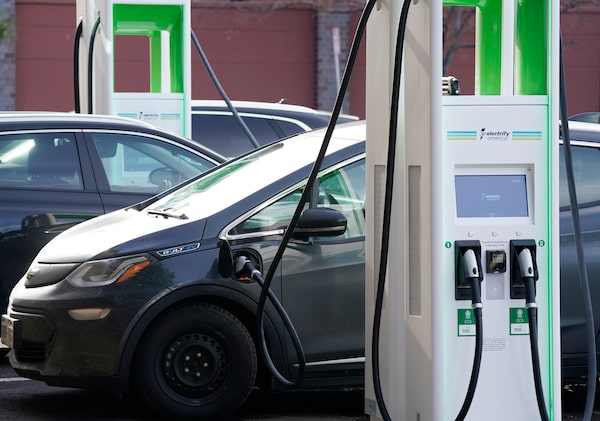
A Chevrolet Bolt charges at an Electrify America site, in Lakewood, Colo., on Dec. 21, 2020.David Zalubowski/The Associated Press
When Allan Soon drove with his parents from Calgary to Vancouver in his Tesla Model Y this summer, there was a complaint about all the charging stops.
“The complaint was that I didn’t give my folks enough of a break,” said Soon, 40, a Calgary-based engineer. “I think in total the charging added like an hour.”
With five charging stops at Tesla superchargers, the 972-km trip took just over 11 hours, Soon said. Three of the charging stops took around 10 minutes and two, in Kamloops and Revelstoke, took around 25 minutes.
“There were limited charging stalls there, so we had to wait,” said Soon, who arrived at his Richmond, B.C., hotel with a 20 per cent charge.
The secret for a fast trip? Shorter bursts of charging. Soon used A Better Route Planner (ABRP), an EV route-planning app, to decide where and how long to stop. Instead of charging to 80 or 100 per cent each time he stopped, Soon topped up his Model Y Long Range AWD – which Tesla says has a 525-km range, although that may be less in real-world driving – to 60 per cent.
That was a bigger charge than the app recommended at some stops, and for peace of mind, he never let his range get lower than 15 per cent.
Soon’s experience brings up the question: is shorter better when it comes to fast-charging? It might be.
Here’s a quick fast charging refresher. Out of the three levels of charging, fast charging is, well, the fastest.
It makes sense when you can’t wait hours for a charge, like when you’re on a cross-country road trip through steep, range-sapping mountains.
Depending on a lot of factors – including the car’s battery charge, how many kilowatts of power it was designed to accept, the speed of the charger and even the temperature outside – fast chargers can quickly charge an EV from zero to 80 per cent in about 30 to 45 minutes.
But if 80 per cent is good, 100 per cent is better, right? Probably not.
While you want to get enough juice so you can make it to the next charger, charging to 100 per cent might be wasting time to add 50 km of extra range that you might not need. That’s because if you keep charging past 80 per cent, the car’s computer slows down the charging rate to prevent damage to the battery. So, depending on the car, adding that remaining 20 per cent can take another 30 to 45 minutes – or even longer.
While ABRP’s developers didn’t immediately respond to questions, the app lets you choose options, including the fastest route to get to your destination or the route with the fewest number of stops. It showed that Soon’s trip would have taken at least 20 minutes longer if he’d stopped just three times but charged for up to 40 minutes each time.
That said, I know not everyone drives a Tesla, whose superchargers can add up to 200 miles (320 km) in about 15 minutes. That’s why I decided to take a 2021 Volvo XC40 Recharge – which has a reported range of 335 km – on a 470 km trip from Vancouver to visit family outside Kelowna.
That’s a trip I usually do with two stops, in Hope and Merritt, to charge to full each time just so I don’t have to worry. That usually adds an hour and 45 minutes to the trip, and I charge to full because I want to be ready in case a charger is broken, or is being used, along the way.
According to ABRP, I would need just one 29 minute-charge – from 13 to 67 per cent – at an Electrify Canada station in Merritt, about 270 km from Vancouver. But when I typed the destination into the XC40′s Google-powered navigation, it said I wouldn’t have enough charge to get to Merritt.
To be safe, I added a ten-minute charging stop at a Petro-Canada station in Abbotsford, a suburb about 70 km away from Vancouver. That ten-minutes turned into 17 minutes because I was stuck in line at the McDonalds next door waiting for an Egg McMuffin and decaf.
I left Abbotsford with a 90 per cent charge.
The XC40 doesn’t show you how much range you have until the battery gets low. Instead, like an iPhone, it just shows how much charge you have left.
With another 20-minute stop in Merritt – this time spent in line inside Tim Hortons – I got to Kelowna with about 20 per cent left on the battery.
In total, the trip took me under five hours and I spent 37 minutes charging. All that time was spent getting coffee and food or checking work e-mails – all of which I would have had to do anyway.
There was no wandering around a parking lot, wondering how I’d spend the next hour before my car charged to full.
The verdict on shorter charging stops? I’ve been converted. They’re still not as fast as pumping gas, but they make EV road trips a lot more like road trips in a gas-powered car.
Shopping for a new car? Check out the Globe Drive Build and Price Tool to see the latest discounts, rebates and rates on new cars, trucks and SUVs. Click here to get your price.
 Jason Tchir
Jason Tchir